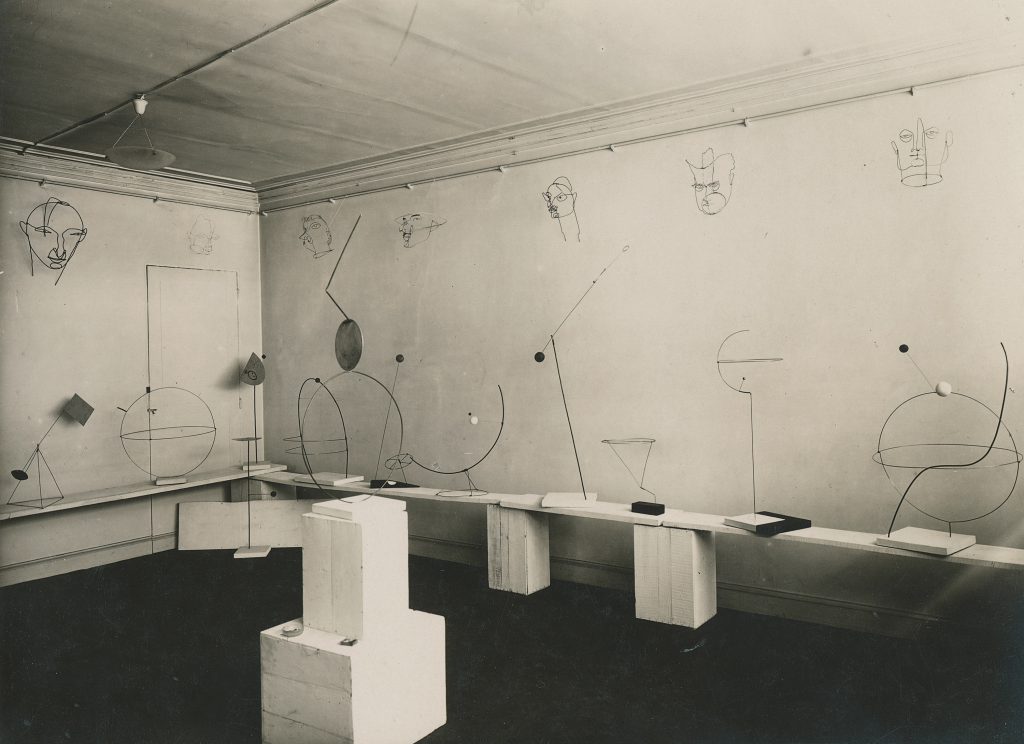
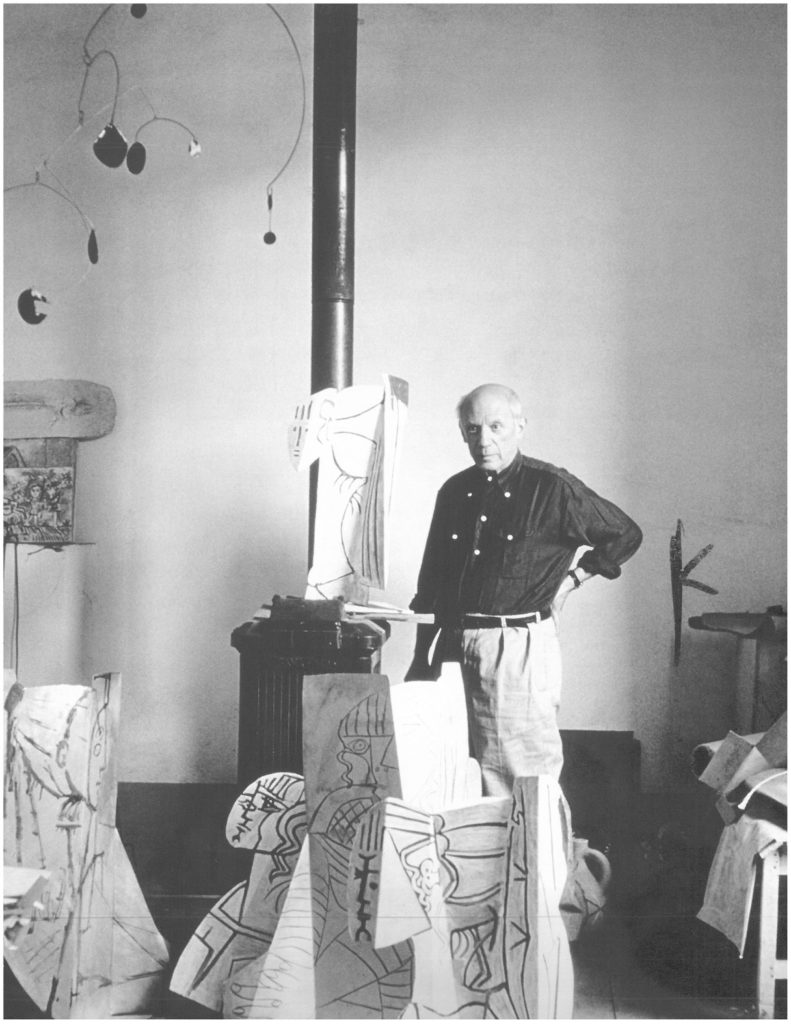

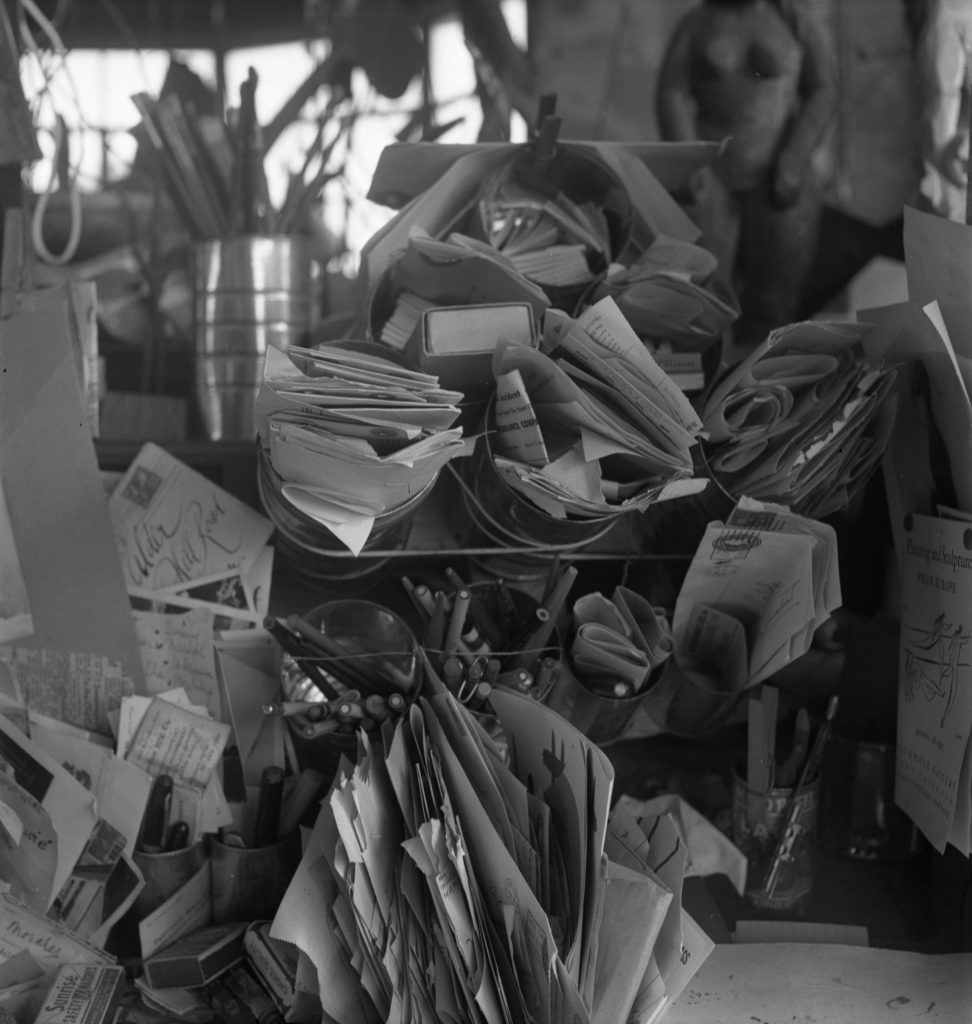
A line relates, connects. It is an integral means of determining rhythm. Reflection shows, however, that what gives the just relationship in one direction constitutes individuality of parts in the other direction.[1]
—John Dewey
In his preface to 23 Gravures, a portfolio of etchings published in Paris in the summer of 1935, Anatole Jakovski proclaimed, “I salute you, painters, sculptors, engravers, fortune-tellers of good adventure, unique psychics of this beautiful spectacle that is the night, black and death.”[2] Among the artists lauded by the French-Moldovan critic on the eve of World War II were Jean Arp, Alexander Calder, Alberto Giacometti, Julio González, Jean Hélion, Wassily Kandinsky, Fernand Léger, Joan Miró, Pablo Picasso, and Marcel Duchamp (whose contribution to the portfolio was mysteriously stolen in the production process). Though Calder had moved back to New York from Paris exactly two years prior to the publication date, in part due to the political upheavals in Europe, he clearly maintained his stance at the forefront of the international avant-garde, in this case as the only American in Jakovski’s camp.
While Calder has since been viewed in relation to many of his European contemporaries, his apparent kinship with Picasso is particularly striking. Both were born in the nineteenth century to artist fathers working in the classical tradition, yet both played the hands they were dealt with unflinching ingenuity, perhaps out of sheer will to be only themselves. Picasso’s father was José Ruiz y Blasco, a realistic painter and art teacher from Málaga. Calder’s father was Alexander Stirling Calder, a well-known creator of large public sculpture from Philadelphia, who was also the son of another famous sculptor, Scottish-born Alexander Milne Calder. Before the age of ten both Picasso and Calder began to make their own works of art, and this self-ruling discipline, ushered in by a conventional lineage, at once grounded and augmented their innovations. Both eventually settled in Paris, where they interrogated the very nature of artistic genres while simultaneously respecting the integrity of those genres. André Breton embraced both artists to different degrees, yet they remained unsympathetic to his dictatorial ways. Neither artist aligned himself with Surrealism, though both exhibited in major Surrealist shows in the 1930s and 1940s.[3] Throughout it all, they took a quiet interest in each other’s art and shared many of the same friends and supporters—among them Marie Cuttoli, Henri-Pierre Roché, and Christian Zervos.
However much their paths seem to align, Picasso and Calder were distinct in their endeavors. While connections are often drawn between them, the truth is that they forged ahead in individual yet protean ways, encouraging infinite interpretations. Perhaps nowhere is this more apparent than in reference to their sculptures of the 1920s—celebrated as “drawings in space”—that so radically liberated line from two dimensions into three.
Calder and Picasso first met on 27 April 1931, with interactions thereafter being few and far between. “Picasso came, very early, to my show at Percier,” wrote Calder, “and I was introduced.”[4] Alexandre Calder: Volumes–Vecteurs–Densités / Dessins–Portraits was Calder’s premiere of abstract sculpture in sheet metal, wood, and wire, and it also included about a dozen of his famed wire portraits, along with a series of single-line drawings.[5] Even from this early point, one could intuit the galvanizing predilection for line that would come to emphasize the magnificent unity of Calder’s oeuvre, which was itself subject to reinventions over the course of seven decades. The following February, Picasso also made a point to see the Duchamp-organized Calder: ses mobiles at Cuttoli’s Galerie Vignon, Calder’s first show of mobiles, ingeniously named as such by Duchamp. Calder, bemused in retrospect, wrote, “I heard [Picasso] had been at Gal. Vignon (He comes to new shows hoping to pick up something he can use—I guess) (mechant moi!).”[6] This rare display of ferocity was only natural coming from Calder, an artist who valued “that sensation of construction with a clear conscience,” as he once described his intuitive process to Ben Nicholson.[7] Picasso and his contemporaries surely recognized in Calder this integrity of intuition, and in his works a tangible presence of continual becoming.
Art-world arbiters drew connections between the artists from the start. The wire portraits in the Percier show hung high on the wall above the abstract objects; as one reviewer wrote, “The shadows of these little linear constructions trace a sort of drawing on the white wall in the manner of Picasso.”[8] This parallel was echoed six years later in a review of Calder’s solo show of non-objective works at the Mayor Gallery in London: “Among the nicest pieces are plain wire objects. These, seen against a white wall, are rather like certain abstract drawings of Picasso, and might be used to explain the structure of some aberrated atom, only instead of one drawing you have an infinite number as they turn about on their strings.”[9]
Calder preferred to place or hang his wire portraits, like his mobiles, against an artificial light, with shadows not only conflating drawing and sculpture but multiplicities of perception in two, three, and four dimensions. The transparent volume of a hanging wire sculpture challenges the brain to perceive depth, and as the object spins on its string, the projected shadow moves in and out of focus, creating a three-dimensional effect within two dimensions, all occurring within the fourth dimension of time. “The shadows have their seasons, too”—to quote John Updike’s poem Penumbrae—and seasons, too, have immeasurable contours.[10] It is in this equivocal realm that the perceptual lines of Calder’s wire objects thrive, like vestigial remnants, saying much with very little.
In July 1937 came the artists’ fabled encounter at the Paris World’s Fair, as documented in photographs by Hugo P. Herdeg (commissioned by Cahiers d’Art). There, Calder’s Mercury Fountain was installed in proximity to Picasso’s Guernica, at the entrance of Luis Lacasa and Josep Lluís Sert’s Spanish pavilion. With Picasso’s imagery of insurmountable destruction set against Calder’s fountain of fluid mercury mined in Almadén, during those summer months in Paris no two works could have seemed more diverse in their affirmation of the Spanish Republic. Two decades later, for the 1953 São Paulo Biennial, Picasso’s Guernica again commanded a space near Calder’s sculptures, which filled the ground floor of Oscar Niemeyer’s Pavilion of States. As one critic so eloquently put it, “[Picasso’s] painting and [Calder’s] artistic intents in motion gradually but effectively transmitted to me the clear perception that the world and its charms, imponderables and mysteries … are always out there, in a state of desuetude, waiting for their revelation at the hands of poets.”[11] In 1958, the two artists joined Arp, Miró, Isamu Noguchi, Rufino Tamayo, and others in commissions for the UNESCO headquarters in Paris—designed by Marcel Breuer, Pier Luigi Nervi, and Bernard Zehrfuss—with Picasso’s The Fall of Icarus and Calder’s Spirale.
Beyond the limelight, Calder and Picasso crossed paths from time to time. In 1952, Calder and his wife Louisa had lunch with Picasso and his family at the home of Cuttoli. They reconvened the following year, during the Calders’ yearlong sojourn in Aix-in-Provence. In an unpublished manuscript, Calder writes amusingly about the second encounter:
Louisa and I drove from Aix to have lunch with Cuttoli and Laugier at Antibes. After lunch I asked if we could see Picasso. So Marie took us to Vallauris—on the way we saw a sign “16 Potiers veulent vous montrer leur travail” [16 Potters want to show you their work]. Finally we came to a shop, where there were pretty bad things, mostly, but a few Picassos. We stood around a while, and finally le maître appeared—Mme Cuttoli had sent in word that she was there. He was quite cordial, and took us into the shop and showed us things. Finally he showed a platter, with a bull-fight in the middle, and decorated around the rim with raised ridges. I said “Ça c’est pour que la viande ne dérape pas” [That’s so the meat doesn’t slide]. I didn’t notice, but a friend standing behind me later told us that he got red in the face. I haven’t seen him since.[12]
Archival photographs from the 1950s speak to a Picasso-Calder narrative. In one from 1954, Picasso stands in his Vallauris studio, surrounded by sheet-metal sculptures of Sylvette David, his model at the time, with a mobile hanging high above him. While the mobile’s origin is unknown—the creator was neither Calder nor Picasso—its presence is evocative. Photographs taken by Herbert Matter of Calder’s Roxbury studio desk in 1950 show Picasso memorabilia, namely a photograph of Femme assise dans une chaise (1938) and a 1947 catalogue from Buchholz Gallery/Curt Valentin that features Femmes devant la mer on the cover (1920). This drawing was one of two Picassos in Calder’s collection, the other being an oil painting, Mandoline, cruche et verre (1959). While a constellation of connections takes many forms within these flexibly framed encounters, a statement made by Picasso distills the crux of both innovators’ works: “To me there is no past or future in art. If a work of art cannot live always in the present it must not be considered at all.”[13]




As so often happens in art world praxes, completely disparate artists who have never interacted begin to think about similar things and how to achieve them. Such is the case with Picasso and Calder, who shared a spirit of iconoclasm that revealed itself through “drawing in space,” or the delineation of non-space.
It is a common misconception that the phrase originated with Julio González in 1932, writing in reference to Picasso’s diagrammatic iron maquettes from 1928. Rather, it was coined in 1929 to describe Calder’s figurative wire sculptures, which he had formally realized in 1926 (though he had been using wire to sculpt since childhood). These works were a new type of massless sculpture in which expressive lines of wire defined spatial volumes suggestive of forms, be they animals, personalities of the day, friends, or mythological figures. Instead of calling them “sculpture,” Calder was known to call them “objects,” to indicate his break from the tradition of sculpting in marble, bronze, and clay. As he later remarked in an interview in 1959, “What I want to avoid is the impression of mud piled on the floor.”[14]
The earliest documented use of “drawing in space” in terms of Calder’s practice appeared on 2 February 1929 in a review of Sculptures bois et fil de fer de Alexandre Calder, the solo show at Galerie Billiet-Pierre Vorms, Paris. Writing for Paris-Midi, a critic announced:
The Independants had accustomed us to wire sculptures. Mr. Alexander Calder personally takes over the perilous exercise. Horses rear up, riders brace themselves, dancers throw to the sky legs more rigid than doorbell wires. It looks like a drawing in space. One can imagine the patience of the sculptor armed with pincers and pliers and uncoiling around his stele the spool of copper wire that he will twist and untwist to give birth to figures. Games for drawers with vigorous wrists.[15]
On the following day, the phrase again appeared in Paul Fierens’s review of Calder’s work at the Salon de la Société des Artistes Indépendants, Grand Palais des Champs-Elysées, published in Journal des Débats. Writing in reference to Romulus and Remus and Spring, both large-scale wire sculptures from 1928 that incorporated classical themes, Fierens remarked:
A humorist, ultimately, the great success of laughter of the present Salon: Calder. With wire and some pieces of wood, in an amusing form, that he arranges in the right place, he constructs a figure that resembles a Modigliani drawing and he crouches Romulus and Remus under the absent body of the nourishing she-wolf. The serious people shrug their shoulders. We must admit that the joke didn’t seem bad to us. This drawing in space, which Calder didn’t invent, he uses it with the pretty verve of a caricaturist and even something more.[16]
Four months following Fierens’s review, Edouard Ramond wrote of Calder’s practice in Paris Montparnasse:
Whether this wire bends itself poorly into a curve, whether it clings inappropriately and will be the end of all sculpture: we will have before our eyes the metal portrayal of a drawing in space, we won’t have a well-evoked mass.[17]
That Calder gained recognition at a time when the notion of transparency was among the most crucial of the avant-garde’s concerns may have prompted critics, in the manner of Fierens, to throw into question who “invented” what—despite the fact that Calder was the first to literally draw in space with wire, bringing to sculpture a state of transparency like none other. It is often mistakenly surmised that Calder was informed by the Cubists, Futurists, and Constructivists, who had sought to achieve transparency through a variety of unconventional means (including glass, Plexiglas, celluloid, and wire), yet he was unaware of their experiments when he arrived in Paris to expand upon his practice in 1926. It was not until three years later, in a statement from January–February 1929—written around the same moment that works such as Romulus and Remus and Spring were making a splash at the Grand Palais—that he situated himself within the discourse:
There is one thing, in particular, which connects them [the wire sculptures] with history. One of the canons of the futuristic painters, as propounded by Modigliani, was that objects behind other objects should not be lost to view, but should be shown through the others by making the latter transparent. The wire sculpture accomplishes this in a most decided manner.[18]
Three years after the term “drawing in space” appeared in the Parisian newspapers in relation to Calder, a variation on the phrase emerged, in a completely different context, in a manuscript by González known as “Picasso sculpteur et les cathédrales.” Interestingly, the 1932 text was not published in its entirety until 1978, more than four decades after it was first written. In what remains one of the most revealing documents on his collaboration with Picasso, González writes:
Only a cathedral spire can indicate a point in the sky where our soul rests in suspension. As in the restlessness of the night, the stars mark out points of hope in the sky, [so too] this immobile spire marks out an infinite number of them to us. It is these points in the infinite which are the precursors of this new art: To draw in space.[19]
Picasso and González’s partnership began in the spring of 1928 on the occasion of Picasso’s commission to create a monument for his longtime friend, Guillaume Apollinaire, who had died ten years prior.[20] That fall they translated Picasso’s line drawings, which were made in Dinard the previous summer, into four iron constructions, or maquettes for the monument. Picasso sought inspiration not from the requirements of the Society of the Friends of Apollinaire, who had a traditional bust in mind, but rather the very writings of Apollinaire—specifically Le poète assassiné, in which Tristouse Ballerinette responds to l’Oiseau de Bénin’s concept for a monument for the larger-than-life Croniamantal: “A statue of nothing, of a void, that is magnificent.”[21] Two of Picasso’s maquettes were submitted to the committee in 1928. They were never formally accepted, and it was not until 1962 that an enlarged version was made, this time as a model for a monumental version constructed in 1972 for the Museum of Modern Art, New York.
Much as he drew inspiration from the work of Apollinaire, Picasso was fascinated by celestial maps. In a statement attributed to Picasso, which relates to his 1924 series of dot-and-line drawings from Juan-les-Pins—often suggested as conceptual blueprints for his maquettes—the artist remarks:
I’m a great admirer of celestial maps. They seem beautiful to me irrespective of their meaning. So one fine day I started drawing a huge number of points linked by lines and blots that seemed suspended in the sky. I had the idea of using them in my compositions, introducing them as purely graphic elements.[22]
Taken together, González’s, Apollinaire’s, and Picasso’s words lend the maquettes for a monument to Apollinaire a chimeric presence beyond figuration or abstraction, one that engages both spatial and temporal notions of monumentality by way of constellating lines that seemingly collide light years away. In 1948, Daniel Henry Kahnweiler added another layer of imagery to them when he wrote:
The wire constructions … constitute a sort of drawing in space, but at the same time form the first step toward the conquest, by sculpture, of a domain that had previously never belonged to anything but architecture: the creation of space. They are, in fact, not only line drawing in space, but they define it in fragments.[23]
While “drawing in space” can be pinpointed to that famed Picasso-González collaboration, it transcends any hard-and-fast designation in terms of Calder’s output. Although it was coined to describe his figurative wire sculptures, “drawing in space” also conjures the gestural lines of his abstract compositions from the early 1930s, and the lines of energy that went on to define the mobiles’ wire armatures drawn effortlessly and yet immaterially in space, whose elements engage in compositional stunts. It even conjures the edges of steel sheets in his monumental works from the 1950s onward, which resonate in the moment of release between the mass and the massless. Writing in 1933 for Cahiers d’Art—two years before he produced 23 Gravures—Jakovski precipitated this immense measure of Calder’s line:
Although it was only a medium for modeling, wire soon became an autonomous element to which Calder would subordinate everything else. But this wire was no longer the same, it had lost its weight: a delicate ellipse of india ink drawn across the firmament with the pen; a trajectory of unknown solid bodies that had to be discovered—and those bodies were as precise, as unreal, as that curve described across space: the sphere.[24]
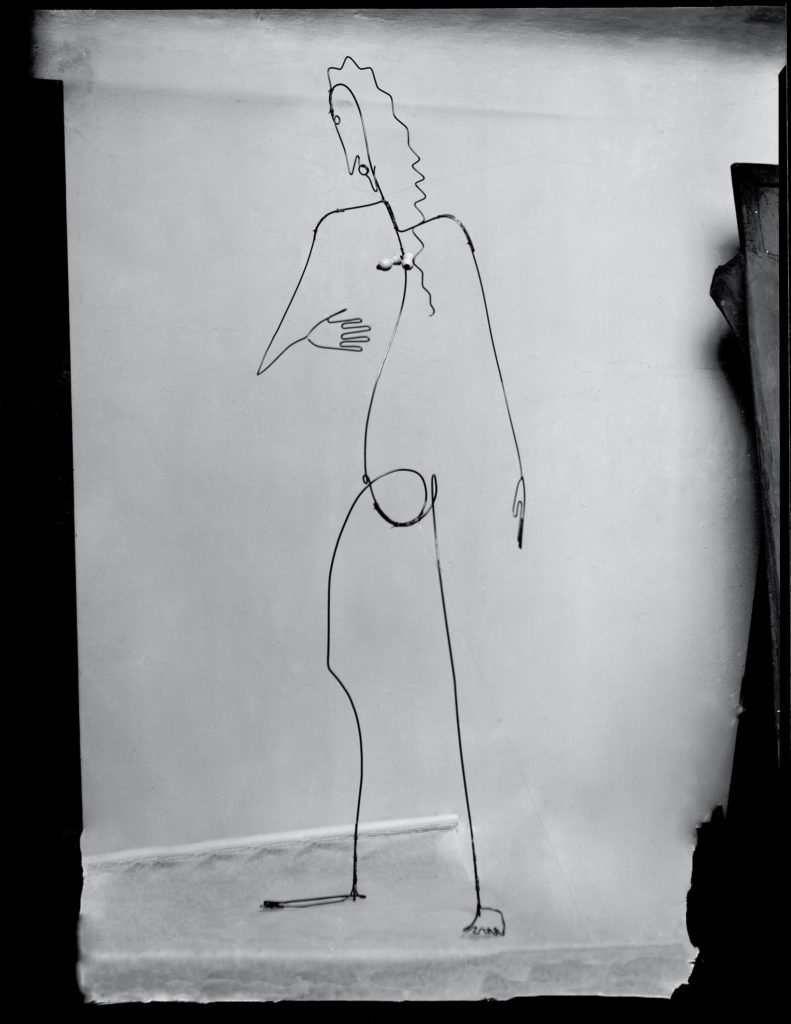
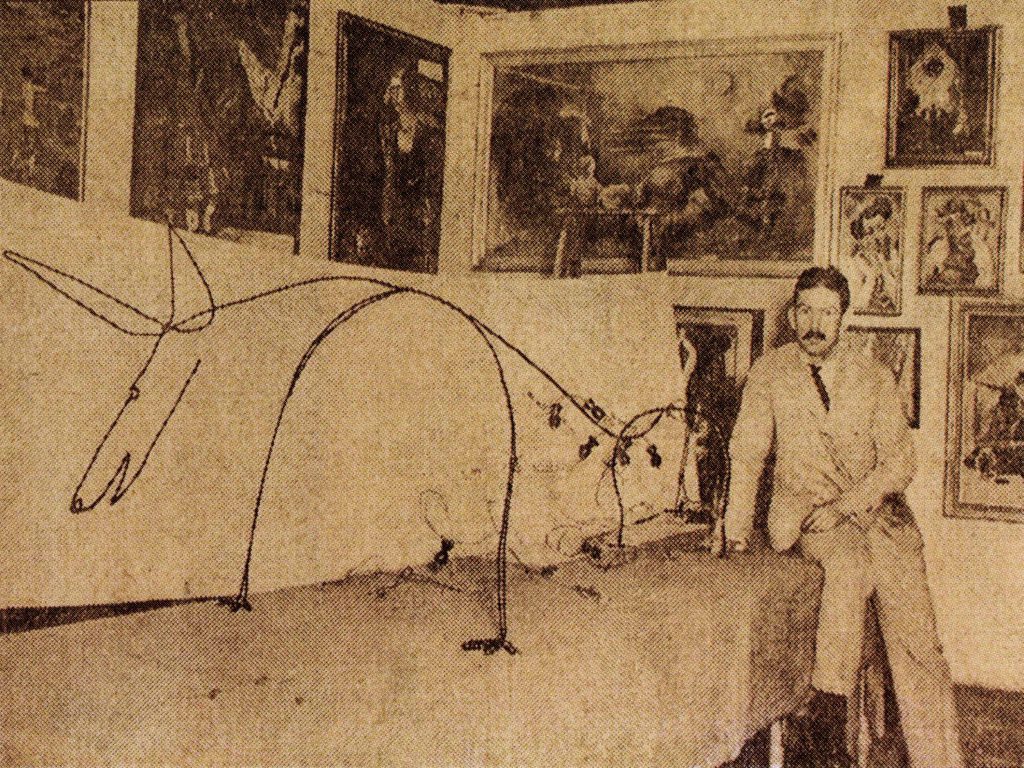
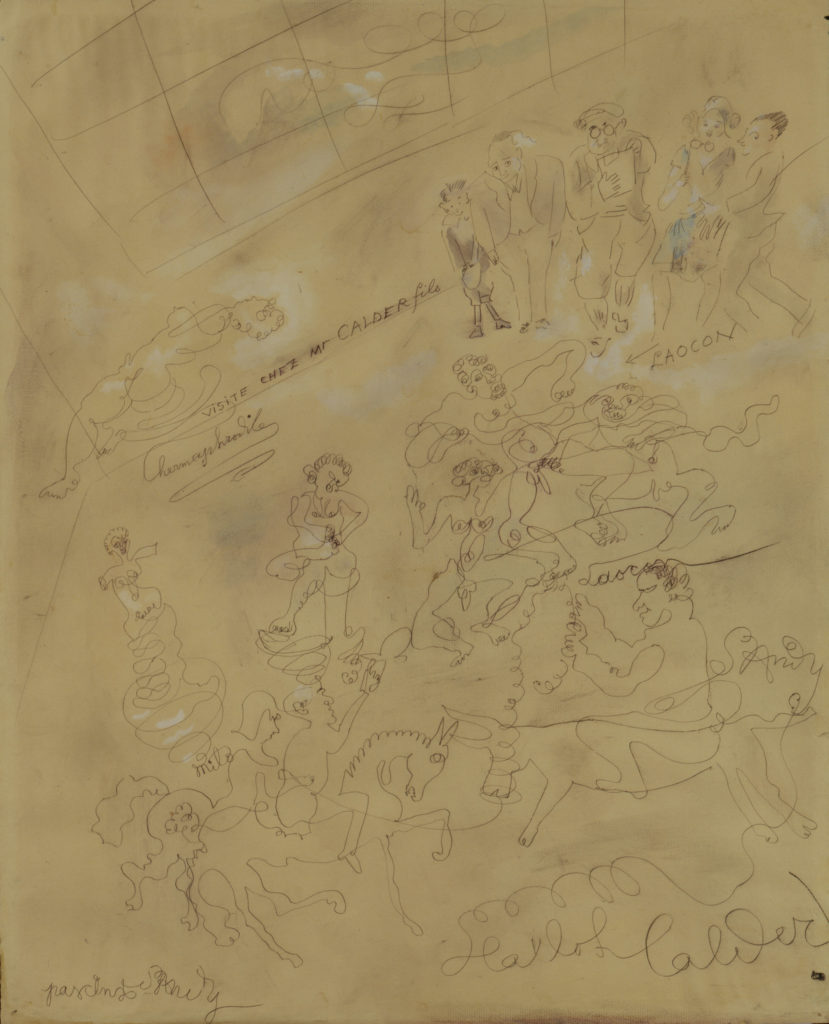
Jules Pascin, Visite chez Mr. Calder fils, c. 1928
Private CollectionJules Pascin, Visite chez Mr. Calder fils, c. 1928
Private Collection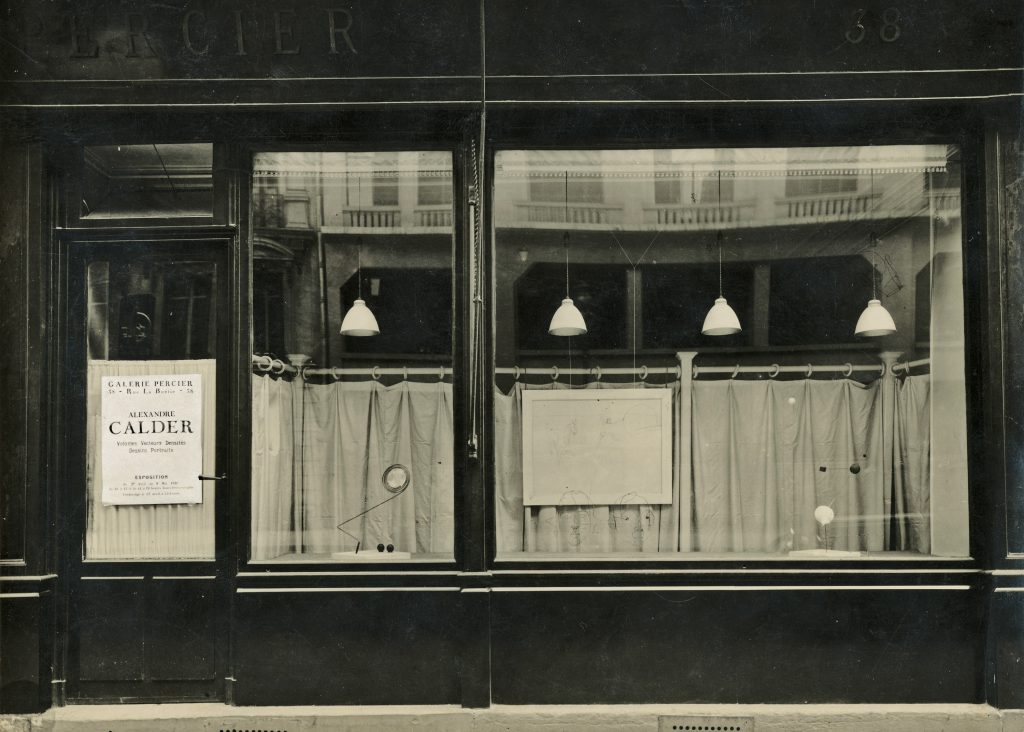
In 1929, one of Picasso’s maquettes for the monument to Apollinaire appeared in Cahiers d’Art. This particular revue was distributed around the same time as the newspapers that first described Calder’s wire sculptures as “drawings in space.”[25]
Whether or not Calder saw the reproduction of Picasso’s maquette, his own developments in wire were already mature. And while his fabled experience in Piet Mondrian’s studio the following year would spur his transition into abstraction by way of its impressive environment-as-installation, it would be a nuanced shift at best—merely an awakening to a language for which, since childhood, Calder had already been honing a singular dialect. “‘Spontaneity’ is the result of long periods of activity,” writes Dewey, “or else it is so empty as not to be an act of expression.”[26] Calder’s enterprise in wire originated not from the European avant-garde but rather his American roots. It began with observing his father and grandfather in their studios, both classical sculptors who bent rod and wire into armatures to support their clay exercises. The very wire sculptures, Romulus and Remus and Spring, that were shown in the 1929 Salon, and that Fierens described as “drawing in space,” can be considered Calder’s way of engaging the traditions of his father and grandfather and updating them. These two objects were part of a series made in 1928 (the third being Hercules and Lion) that introduced not only the size but the subject matter commonly associated with classical art. Spring stood more than seven feet tall and referenced the allegory of Spring, and Romulus and Remus was over ten feet wide, referencing the myth of the founders of Rome.[27] Moreover, Spring was a pun on the medium—the young woman holding a flower could “spring” back and forth when pulled—and Hercules and Lion could rotate with air currents as it hung from the ceiling, projecting shadows of the subjects’ convolutions on the wall. These works at once marked Calder’s maturity in wire, distinguished him from his forebears, and signaled the intentions he had yet to realize in scale and presentation.
Whereas Picasso was drawn to fire and metal, welding iron with an acetylene torch, Calder was immediate in his approach, respecting the integrity of the raw material. “It must be the twitching of my fingers—even naked (without pliers),” he once declared, “which makes me want to be plastik!”[28] That Calder was exposed to the American Arts and Crafts movement in Pasadena, California, in the early 1900s lent to his process what Mário Pedrosa once called a “spiritual prescience for the actual material.”[29] This quality marked his earliest known sculptures, Dog and Duck (both 1909), bent into formation from trimmed brass sheeting. Among his first all-wire sculptures, made prior to moving to Paris, was a valentine for his mother done in 1925. The following spring, while living in an apartment in New York City on West 14th Street, he created from a single piece of wire a sundial in the shape of a rooster—an apparatus at once pragmatic and miraculous in that it channels an immaterial notion. One cannot help but make the conceptual leap from the sundial, wherein shadows guided by the sun tell time, to the wire portraits that he began to make in Paris the following fall, wherein the shadows actuate an experience in the viewer’s present time by engaging a perceptual totality.
Another significant event in terms of Calder’s development occurred on 9 June 1922, while he served as a fireman in the boiler room of the H.F. Alexander, sailing from New York to San Francisco via the Panama Canal:
It was early one morning on a calm sea, off Guatemala, when over my couch—a coil of rope—I saw the beginning of a fiery red sunrise on one side and the moon looking like a silver coin on the other. Of the whole trip this impressed me most of all; it left me with a lasting sensation of the solar system.[30]
It was not the actual planets or stars that impressed Calder—an unfortunate misinterpretation that has been perpetuated over time—but rather the invisible forces at play in the universe, or the immeasurable immensity of our existence. While his abstract objects, particularly those from his 1931 Percier exhibition, evoke this sensation of the sublime through massless spheres and radiating vectors, its nascent form emerges in those early “drawings in space” by way of vibrations, actual articulations, gestural evocations, and perceptual complexities. They were neither indicators of outer space nor creators of defined space, in the manner of Picasso’s maquettes, but rather activators of the immediate, surrounding space, works that open up the shape of our aesthetic experience by representing “aliveness,” even boundlessness.
Although they evolved in Paris, Calder’s wire sculptures premiered in New York in 1928, where critics—in advance of their Parisian counterparts—used graphic terminology to describe them. “With wire alone he has outlined in space a score of subjects, ranging from a head of Coolidge to a sway-back horse,” one wrote when Josephine Baker I (1926), Calvin Coolidge (1927), and other figures made their New York debut in Wire Sculpture by Alexander Calder at the Weyhe Gallery.[31] When Calder exposed the “virtues and vices,” to quote the artist, of Romulus and Remus at the Twelfth Annual Exhibition of the Society of Independent Artists at the Waldorf Astoria hotel (where Spring was also on view), another critic wrote: “The body and limbs were sketchily expressed with a single thickness of wire, while the paws, eyes, mouth, ears and other features were expressively done in coils, kinks and loops of wire.”[32] These writers suggested the hybrid nature of Calder’s vernacular—one that wed two longstanding genres, which James Johnson Sweeney would later crystallize in his introduction to Calder’s famed 1943 retrospective at the Museum of Modern Art, New York:
[The wire works] were now three-dimensional forms drawn in space by wire lines—much as if the background paper of a drawing had been cut away leaving only the lines. The same incisive grasp of essentials, the same nervous sensibility to form, and the same rhythmic organization of elements, which are virtues of a drawing, were virtues of this new medium.[33]
To understand the significance of “drawing in space,” it is important to touch upon its avant-garde precedent. Single-line drawing, or continuous line drawing, was a varied practice during the early twentieth century on both sides of the Atlantic. It manifested by way of drafting exercises, caricatures, and formal figurative and literary explorations, and its proponents ranged from Picasso and Henri Matisse to John Sloan and Boardman Robinson, both of whom taught Calder at the Art Students League, where he was enrolled from 1923 to 1925. In his autobiography, Calder credited Robinson as encouraging him to draw with “a pen and a single line.”[34]
One of the most famous examples of the single-line style to emerge during this period was Picasso’s 1919 cover design for the piano reduction of Igor Stravinsky’s Ragtime, widely distributed in France and England by the early 1920s. Here Picasso’s distinct yet mellifluous line spoke to Stravinsky’s cross-fertilization (appropriating ragtime in his own highly original oeuvre), as it did to a visual condensation of sound. For Picasso, single-line drawing played a constituent role in his practice, reimagined in a multitude of styles, techniques, and subject matter, from the looping liveliness of his harlequins of the 1910s to the surreal nudes of the 1930s. One of those who directly imitated his style was Jean Cocteau, whose Dessins (1923) was an outspoken riff on Picasso. Notably, Calder’s wire portraits proved equally compelling for the French filmmaker, who in 1930 devised a self-portrait from pipe cleaners, which played a haunting role in his film The Blood of a Poet.[35]
When Surrealism exploded on the Parisian art scene in 1924, André Masson inaugurated the notion of pure automatism set forth by Breton with automatic drawings, a technique of drawing without conscious control. Many of Masson’s contemporaries explored this approach, including Arp, Salvador Dalí, Max Ernst, Miró, and Kurt Seligmann. Many tapped into an unconscious realm through painting, as seen in Miró’s The Birth of the World (1925). Around 1928, Jules Pascin paid tribute to Calder in Visite chez Mr. Calder fils, a single-line drawing that renders Calder on a horse, creating Greek sculptural motifs out of “drawn” wire, including Hermaphroditus, Milo, and Laocoön, recalling the very allegorical sculptures that would come to inspire the phrase “drawing in space.”
The antecedents to these modern currents are vast. Cave paintings in Southern France, from the Chauvet-Pont-d’Arc (c. 30,000 BC), Lascaux (c. 15,000 BC) and Niaux (11,500–10,500 BC) are among the earliest known experiments in line, yet only the Niaux had been discovered by the early twentieth century. In Calder’s first treatise on drawing, called Animal Sketching (1926), in which he expressed the energy of animals in solid black strokes of ink, he drew upon this prehistory of originality: “The earliest men of which we have any record, thousands of centuries ago, expressed their sense of beauty by leaving pictures drawn on their cave dwellings.”[36] Legrand-Chabrier, the distinguished French cultural critic who specialized in the circus arts, also recognized the continuum in Cirque Calder (1926–31): “Here is a dog who seems like a prehistoric cave drawing with a body of iron wire. He will jump through a paper hoop. Yes, but he may miss his mark or not. This is not a mechanical toy.”[37] Years later, Calder and his family visited the Lascaux caves—as did Picasso—which opened to the public after World War II.
Other sources include ancient engravings on Etruscan objects (700 BC); Nazca lines in the Peruvian desert (AD 200–600); the caricatures by seventeenth-century Italian sculptor Gian Lorenzo Bernini, especially his caricature of Cardinal Scipione Borghese; William Hogarth’s serpentine “line of beauty,” as defined in his treatise The Analysis of Beauty (1753), prophetic of the hypocycloid curves in Calder’s 1940s standing mobiles;[38] John Flaxman’s outline engravings from the late 1700s and early 1800s; Jacques-Louis David’s and Jean-Auguste-Dominique Ingres’s neoclassical paintings, which had a particular importance for Picasso;[39] and Kubota Beisen’s brush-and-ink sketches, which inspired Robert Henri and Sloan in the late 1800s.
It is interesting to recount the voices coming from Calder’s stomping ground at the League. His teacher Sloan once proclaimed, “Line is the most significant graphic means we have. It is entirely a sign, a mental invention. You don’t see lines in nature, only contours of tones.”[40] Henri, though not one of Calder’s teachers, famously instructed his students not to follow any prescribed style, but rather to establish their own style, and this idea likely circulated in Calder’s classrooms as well. To seize the moment rather than look over one’s shoulder to the past, and to render what one sees with individual prowess, extends beyond Henri to the very foundations of the American intellectual tradition as espoused by Ralph Waldo Emerson: “Trust thyself: every heart vibrates to that iron string.”[41] It also reverberates with Dewey, whose words conjure the very continuity of experience inherent in the process of single-line drawing: “In short, art, in its form, unites the very same relation of doing and undergoing, outgoing and incoming energy, that makes an experience to be an experience … The artist embodies in himself the attitude of the perceiver while he works.”[42]
One of the many mysteries of Calder is that in 1930, after he had all but dismissed his figurative wire sculptures in favor of making nonobjective ones, he began to make a formal series of single-line drawings that explored the action and space of the circus. One of these drawings, Horse Trainer with Hoop (1931), was on display in the gallery window at Percier, surrounded by Féminité (c. 1930), a three-dimensional abstraction of Kiki de Montparnasse with a light-reflecting tin disc; Densité I (c. 1931), a stabile of wooden spheres, a wooden cube, and uniting wires that emit weightless alacrity; and wire portraits of Calder’s wife Louisa, Miró, and Michel Tapié. In terms of the fluidity of Calder’s oeuvre, this display is revealing: If we consider Kandinsky’s proposition that line is a point in movement, then the lines of Horse Trainer with Hoop symbolically point backward and forward (and sideways), merging tradition with innovation, tracing a trajectory between drawing and sculpture, representation and abstraction, even individuality and universality. This sweeping view reverberates with Calder’s own description of his work, written in 1932: “Out of different masses, light, heavy, middling—indicated by variations of size or color—directional lines—vectors which represent speeds, velocities, accelerations, forces, etc…—these directions making between them meaningful angles, and senses, together defining one big conclusion or many.”[43]
Free as they were from habituation, both Picasso and Calder explored line drawing in unpredictable ways, not the least by liberating line altogether in those revolutionary sculptures from the 1920s. In 1949, Picasso sketched various objects in space with a penlight, captured on camera by Gjon Mili, and in 1956 he drew figures on transparent surfaces in Henri-Georges Clouzot’s film Le mystère Picasso. Both Calder and Picasso illustrated books, and it was through a series of haunting drawings for E. E. Cummings’ Santa Claus: A Morality (1974) that Calder returned to pure line just two years before his death—a time when he was creating the most massive sculptures of his career. “To know what you want to draw, you have to begin drawing it,” Picasso told Brassaï.[44] It is this visceral energy that underscores Calder’s and Picasso’s explorations in line, at once fleeting and enduring, fortuitous and perennial, exceptional and unceasing.
Hauser & Wirth, Somerset, England. Calder: From the Stony River to the Sky. Exhibition catalogue. 2018.
Susan Braeuer Dam, For the Open Air
Jessica Holmes, More than Beautiful: Politics and Ritual in Calder’s Domestic Items
Solo Exhibition Catalogue“Calder in France.” Cahiers d’Art, no. 1 (2015). Edited by Alexander S. C. Rower.
Susan Braeuer Dam, Calder in France
Robert Melvin Rubin, An Architecture of Making: Saché and Roxbury
Agnès Varda in conversation with Joan Simon
Magazine, MonographMuseo Jumex, Mexico City. Calder: Discipline of the Dance. Exhibition catalogue. 2015.
Alexander S. C. Rower, Calder: Discipline of the Dance
Solo Exhibition CatalogueMusée Picasso, Paris. Calder-Picasso. Exhibition catalogue. 2019.
Bernard Ruiz-Picasso and Alexander S. C. Rower, Confronting the Void
Chus Martinez, No Feeling Is Final
Group Exhibition Catalogue